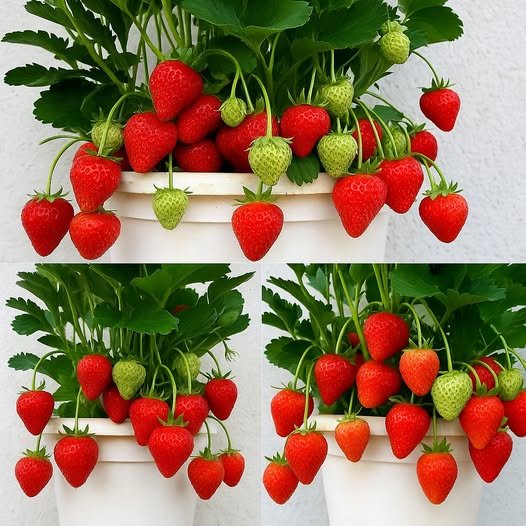How to Grow Strawberries Anywhere – Follow This Method for Success
Strawberries are one of the most rewarding fruits to grow, offering sweet, juicy berries packed with vitamins and antioxidants. The good news? You don’t need a large garden or perfect soil to grow them successfully. By following the right method, you can cultivate strawberries anywhere—whether in pots, vertical gardens, hanging baskets, or even hydroponically. This guide will show you step-by-step how to grow strawberries effortlessly, no matter your space or location.
Why Grow Your Own Strawberries?
Homegrown strawberries have several advantages over store-bought ones:
Better Taste: Freshly picked strawberries are much sweeter and more flavorful.
No Harmful Chemicals: You control how they are grown, ensuring they are free of pesticides and additives.
Cost Savings: Store-bought strawberries can be expensive, while homegrown ones provide continuous harvests at a lower cost.
Fun and Rewarding: Growing strawberries is a fun gardening project for the whole family.
Choosing the Right Strawberry Variety
There are three main types of strawberries, and choosing the right one depends on your growing conditions and goals:
June-bearing Strawberries: Produce a large, single crop in early summer. Best for large harvests.
Ever-bearing Strawberries: Produce two to three smaller harvests throughout the year.
Day-neutral Strawberries: Produce fruit continuously, as long as temperatures remain moderate.
For small spaces or container gardening, day-neutral or ever-bearing varieties work best because they provide fruit over an extended period.
How to Grow Strawberries Anywhere
No matter where you live or how much space you have, strawberries can be successfully grown using these techniques.
1. Growing Strawberries in Containers
- Choose a container that is at least 6–8 inches deep and has drainage holes.
- Use high-quality potting mix with compost for nutrients.
- Plant strawberries 12 inches apart to allow for spreading.
- Place the container in a sunny location with at least 6–8 hours of direct sunlight daily.
- Water consistently to keep the soil moist but not soggy.
2. Growing Strawberries in Hanging Baskets
- Hanging baskets save space and keep strawberries away from pests.
- Use lightweight, well-draining soil and a basket at least 10 inches in diameter.
- Plant strawberries so their roots are fully covered but the crown remains above soil level.
- Hang the baskets in a sunny spot and water regularly.
3. Vertical Strawberry Gardening
Vertical planters maximize space and are ideal for balconies or small patios.
Use stackable planters, wall-mounted pockets, or PVC pipes with cut-out holes for planting.
- Ensure good drainage and position the vertical garden where it receives adequate sunlight.
4. Growing Strawberries in Raised Beds
- If you have a backyard, raised beds provide excellent drainage and prevent weed competition.
- Use well-draining, fertile soil mixed with compost.
- Space plants 12–18 inches apart to allow for runners to spread.
- Mulch around the plants with straw or wood chips to retain moisture and prevent rot.
5. Hydroponic Strawberry Gardening
- Strawberries grow well hydroponically, making them ideal for indoor gardening.
- Use a nutrient-rich water system such as a Kratky method, deep water culture, or NFT system.
- Provide artificial grow lights if growing indoors.
Caring for Your Strawberry Plants
To ensure a successful harvest, follow these essential care tips:
1. Watering
- Keep the soil consistently moist but avoid waterlogging.
- Water in the morning to allow excess moisture to evaporate during the day.
2. Fertilizing
- Use organic compost, fish emulsion, or balanced liquid fertilizer every 2–3 weeks.
- Reduce nitrogen fertilizers once flowering begins to encourage fruit production.
3. Mulching
- Apply a layer of mulch to conserve moisture, suppress weeds, and keep berries clean.
- Straw, pine needles, or wood chips work best.
4. Controlling Pests and Diseases
- Aphids and Spider Mites: Spray plants with neem oil or introduce ladybugs as natural predators.
- Slugs and Snails: Use crushed eggshells around plants to deter them.
- Fungal Diseases: Avoid overhead watering and ensure proper air circulation.
Encouraging More Fruit Production
- Regularly remove runners (long stems that produce new plants) to focus energy on fruit production.
- Harvest strawberries when fully red to ensure the best flavor.
- Pick fruits regularly to encourage more production.
Harvesting and Storing Strawberries
- Harvest ripe strawberries by gently twisting them off the stem.
- Store in the refrigerator for up to 5–7 days.
- Freeze or dry excess strawberries for long-term storage.
Final Thoughts
By following this method, you can successfully grow strawberries anywhere—whether in containers, hanging baskets, vertical gardens, or hydroponically. With the right care, you’ll enjoy sweet, homegrown strawberries throughout the year. Start planting today and experience the joy of harvesting your own delicious strawberries!



